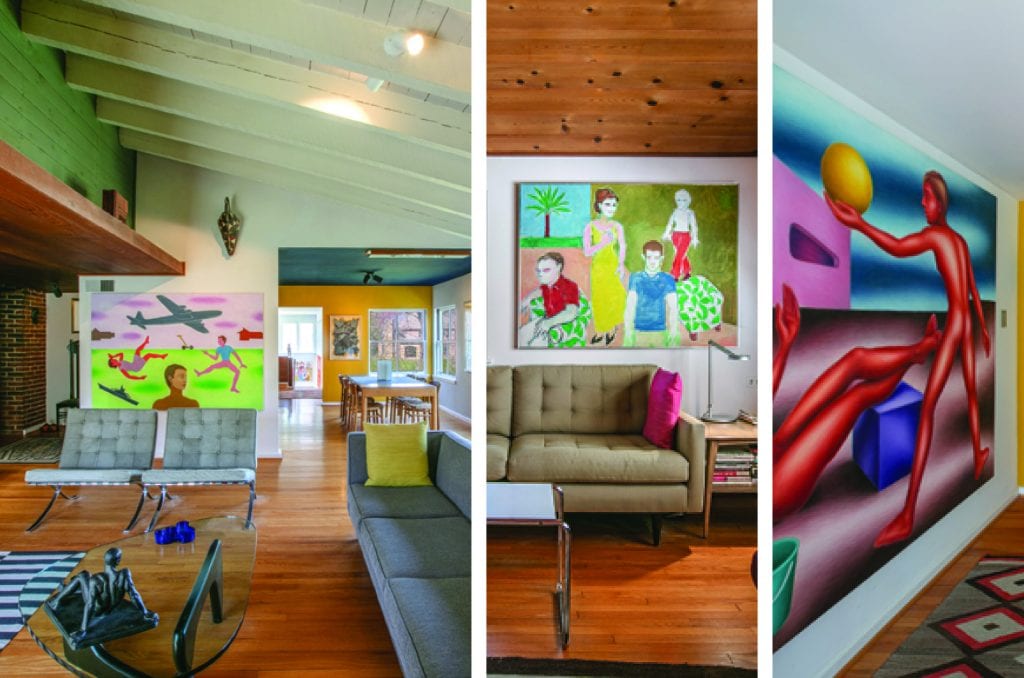Peter Shank was part of the group that saved the Frank Lloyd Wright House in Ebsworth Park, turning the property into a museum and public park. But his connection to mid-century modern architecture in the region runs even deeper. His father was the late Isadore Shank, known as the first modernist architect in St. Louis. Peter now lives in his childhood home with his partner Tim Ocel. Designed in 1939, the house was lauded as revolutionary when it was constructed and remains a local architectural gem.
Have you always lived in St. Louis?
My father graduated with his master’s from Washington University, and in the late ’20s, he opened his own business in St. Louis, which did very well until the Great Depression. He then worked for a company that designed projects for several World’s Fairs, so he and my mother travelled a lot. They came back to St. Louis to start a family and first settled in Webster Groves. While there, my father started designing this house, which was finished when I was around 2. I also graduated from Washington University and then lived in several different places, including France and New York City. I had come back to St. Louis before inheriting this house. I guess you could say it bookends my life.
What did your father want to achieve with the design of the house?
He loved nature. Just like Frank Lloyd Wright, he wanted the house to be part of the landscape. He created this subdivision, and for our home, he picked the most difficult lot to build on. His goal was to create something that worked with the hillside. He also used natural materials like California Redwood. He didn’t like the brick being made in 1940 and wanted to use old materials, but that wasn’t something people really did at the time. He took his contractor to a building, the Green Tree Brewery, which was being demolished, and they picked up all of the bricks, cleaned them and used those, so my dad had handmade bricks from 1870. Thanks to the interior brick walls, my friends when I was young always thought our house was unfinished when they visited.
What is the outdoor space like?
The subdivision has about 7 acres of woods, so it’s like a little nature preserve. When we moved in, we built a gravel path to wind through the acreage, which we’ve built out to bridge over the road to increase access. As a result, more people have discovered the area, especially with the pandemic. We love that it’s become a treasure to so many.
Your entire family is very creative.
My father was an architect, and my mother, Ilse, drew illustrations for magazines like Ladies’ Home Journal, Collier’s and McCall’s. My aunt, Adie Giessow, also lived with us, and she was a jewelry designer with Elleard Heffern Fine Jewelers. Her designs won many national awards, and one piece was even featured on The Today Show. My two brothers, Paul and Stephen, and I are artists, and between the three of us, we’ve had exhibits across the country, as well as overseas. My partner, Tim, is a well-known stage director who has worked across the country and teaches at the conservatory at Webster University. The house is always full of artists, opera singers and actors. It’s been a very lively place over the years.
Can you tell me about your own pieces in the home?
My work is not traditional portraits, but it comes from people and places in my life. In the bedroom, there is a painting called Pentwater, which was inspired by family trips to a town on the coast of Lake Michigan, and in the living room, there is one that is of a visit to my brother in San Francisco. There’s also a piece called Visconti, which is named after Italian film director Luchino Visconti and is the result of attending the Venice Film Festival when I lived in France. A newer piece, which I haven’t named, features a B-29 bomber. It’s about the intersection of the creation of suburban America and World World II.
How do you approach displaying art?
It’s ever changing because I keep making or finding new things. Modern homes have a lot of windows, and I love the natural light, but it makes it a battle for displaying pieces because of the limited wall space. It’s always a challenge to find a place to hang things, so when I have something new, usually something else has to come down. Along with my own work, I keep pieces by my parents, aunt, brothers and some of my old professors. I also collect African masks and sculptures and Navajo rugs.
Do you have any favorite furniture pieces?
Growing up with an architect, I was taught what to appreciate in furniture, so we’ve continued to buy things designed by architects. We have pieces from Eero Saarinen, who designed the Arch, and his father Eliel Saarinen. We have Russel Wright dishes, and items by Mies van der Rohe, Alvar Aalto, Marcel Breuer and my father, who designed our dining room table.
